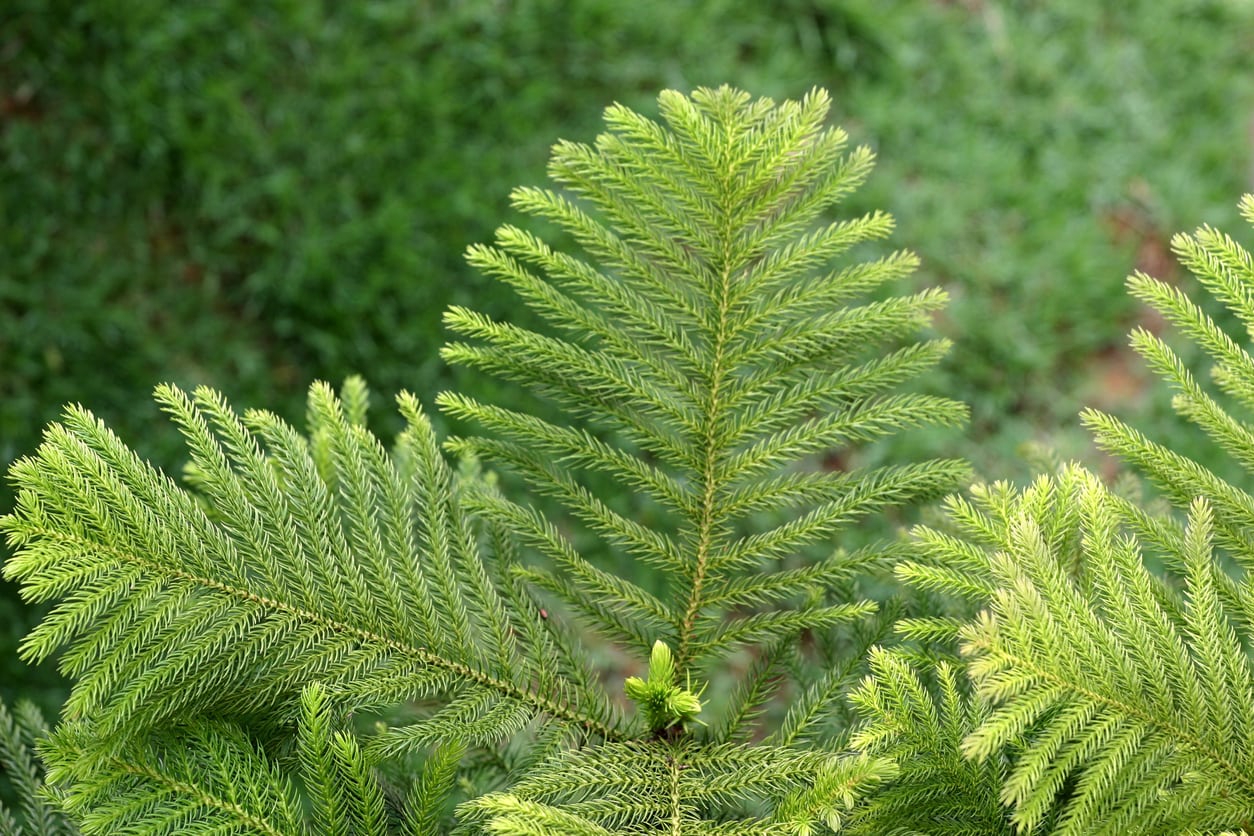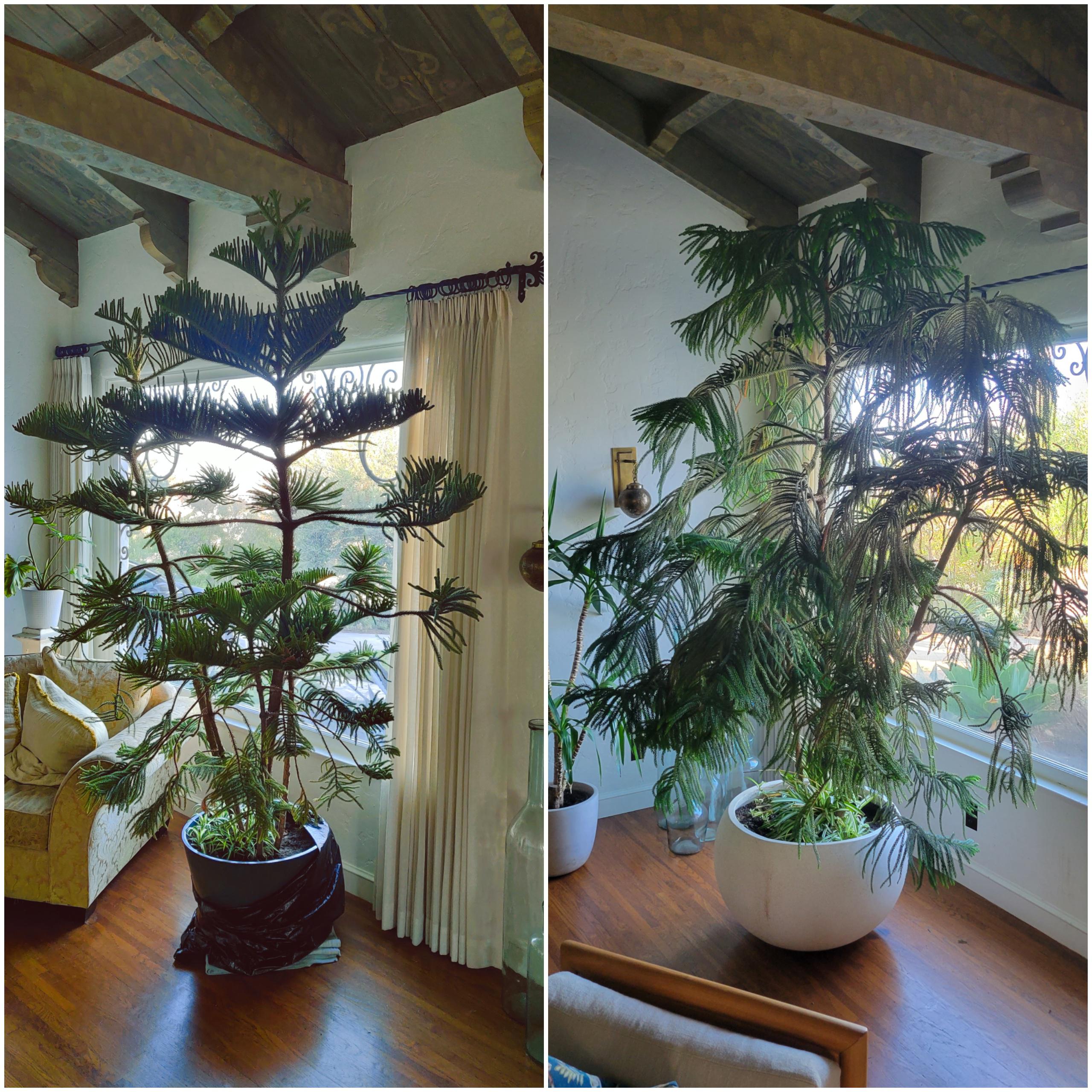As an Amazon Associate, I earn from qualifying purchases.
Yes, a Norfolk Island Pine can be planted outdoors in suitable climates. It thrives in USDA zones 9 to 11.
Norfolk Island Pines, native to the South Pacific, are popular indoor plants. They can also flourish outdoors in warm, humid regions. These trees prefer well-drained soil and full to partial sunlight. They grow tall, reaching heights of up to 200 feet in the wild.
Outdoor planting requires protection from frost, as they are not frost-tolerant. Ensure ample space for their expansive root system and tall growth. Regular watering and occasional fertilization promote healthy growth. Proper care allows these elegant trees to thrive, enhancing garden landscapes.
Ideal Climate
The Norfolk Island Pine is a beautiful, evergreen tree. It can grow both indoors and outdoors. To thrive outdoors, it needs the right climate. Let’s explore the temperature and humidity it needs.
Temperature Requirements
Norfolk Island Pines need warm temperatures. They like temperatures between 50°F and 70°F. In winter, they can tolerate down to 35°F. But they don’t like frost. Frost can damage the tree. Plant them in frost-free zones for best results.
Humidity Levels
These trees love high humidity. They need around 50% to 60% humidity. Dry air can harm them. In dry areas, mist the tree often. This keeps them happy and healthy.
| Climate Factor | Ideal Range |
|---|---|
| Temperature | 50°F – 70°F |
| Humidity | 50% – 60% |
By providing the right temperature and humidity, your Norfolk Island Pine will flourish outdoors.
Soil Conditions
Planting a Norfolk Island Pine outdoors requires specific soil conditions. Ensuring the right soil helps the tree grow healthy and strong. Let’s explore the necessary soil type and pH levels for optimal growth.
Soil Type
Norfolk Island Pine thrives in well-draining soil. This type of soil prevents waterlogging, which can harm the roots. Sandy loam is the best choice because it balances drainage and moisture retention. Avoid heavy clay soils as they hold too much water. You can improve clay soil by adding sand or organic matter.
Ph Levels
The pH level of the soil is crucial. Norfolk Island Pine prefers slightly acidic to neutral pH levels. Aim for a pH between 5.5 and 6.5. You can test the soil pH using a simple kit from a garden store. If the pH is too high, add sulfur to lower it. If too low, use lime to raise the pH.
Here is a simple table to summarize the soil conditions for Norfolk Island Pine:
| Soil Condition | Requirement |
|---|---|
| Soil Type | Sandy loam, well-draining |
| pH Level | 5.5 to 6.5 |
Planting Process
Planting a Norfolk Island Pine outdoors can be a rewarding experience. Follow the right steps to ensure the tree thrives in its new environment. The process involves careful site selection and specific planting steps. Below, we delve into these crucial aspects.
Site Selection
Choosing the right location is key for a healthy Norfolk Island Pine. The tree prefers a spot with full or partial sunlight. Make sure the soil is well-draining to prevent root rot.
Consider the mature size of the tree. Norfolk Island Pines can grow up to 100 feet tall. Ensure there is enough space for the tree to expand.
| Factor | Requirement |
|---|---|
| Sunlight | Full or partial sunlight |
| Soil | Well-draining |
| Space | Room for 100 feet growth |
Planting Steps
- Prepare the Site: Clear the area of weeds and debris.
- Dig the Hole: Make the hole twice as wide and as deep as the root ball.
- Place the Tree: Position the tree in the hole, ensuring the top of the root ball is level with the ground.
- Backfill the Hole: Fill the hole with soil, gently pressing down to remove air pockets.
- Water Thoroughly: Give the tree a deep watering to help settle the soil.
Monitor the tree regularly, especially during the first year. Water it consistently to help establish strong roots. Mulching can also help retain soil moisture and protect the roots.

Credit: gardensnips.wordpress.com
Watering Needs
Understanding the watering needs of a Norfolk Island Pine is crucial. This helps the tree thrive when planted outdoors. Proper watering ensures the tree remains healthy and lush.
Frequency
Water the Norfolk Island Pine regularly. During the growing season, water it once a week. In winter, reduce watering to once every two weeks. Always check the soil moisture before watering.
Watering Techniques
Use a watering can or hose for deep watering. Ensure the water reaches the tree’s roots. Avoid wetting the foliage to prevent diseases. Water in the early morning or late afternoon. This reduces evaporation and keeps the soil moist longer.
| Season | Watering Frequency |
|---|---|
| Spring and Summer | Once a week |
| Autumn and Winter | Once every two weeks |
- Check soil moisture before watering.
- Deep water to reach roots.
- Avoid wetting the foliage.
- Water in the early morning or late afternoon.
Fertilization
Fertilizing your Norfolk Island Pine can help it thrive outdoors. It ensures the tree gets essential nutrients. This section provides tips on the best fertilizers and application methods.
Best Fertilizers
Choosing the right fertilizer is important. Norfolk Island Pines need a balanced formula. Look for a 10-10-10 or 14-14-14 fertilizer. These numbers represent nitrogen, phosphorus, and potassium. They help the tree grow strong and healthy.
Consider using organic fertilizers. They improve soil health and provide slow-release nutrients. Fish emulsion and compost tea are good options. They are gentle and effective for these trees.
Application Tips
Applying fertilizer correctly ensures your tree gets the most benefit. Follow these simple tips:
- Fertilize during the growing season, from spring to early fall.
- Use a water-soluble fertilizer for easy absorption.
- Follow the instructions on the fertilizer package.
- Do not over-fertilize; it can harm the tree.
- Water the soil before and after applying fertilizer.
Here’s a simple table to guide you on application frequency:
| Fertilizer Type | Application Frequency |
|---|---|
| Water-Soluble | Every 4-6 weeks |
| Slow-Release | Every 3-4 months |
Remember, healthy soil is key. Regularly check the soil pH. Norfolk Island Pines prefer slightly acidic to neutral soil.
Pest And Disease Control
Caring for a Norfolk Island Pine outdoors involves managing pests and diseases. This is crucial for the tree’s health. Learn about common pests and how to prevent diseases below.
Common Pests
Norfolk Island Pines can attract several pests. Here are some common ones:
- Spider Mites: These tiny bugs cause yellowing leaves.
- Scale Insects: They leave sticky residue and weaken the tree.
- Aphids: Small insects that suck sap and stunt growth.
To control these pests, regularly inspect your tree. Use insecticidal soap if needed.
Disease Prevention
Preventing diseases is key for a healthy Norfolk Island Pine. Follow these tips:
- Water Properly: Avoid overwatering to prevent root rot.
- Ensure Good Drainage: Plant in well-draining soil.
- Prune Regularly: Remove dead branches to allow airflow.
Good care routines keep your tree disease-free.
| Action | Benefit |
|---|---|
| Regular Inspection | Early pest detection |
| Proper Watering | Prevents root rot |
| Pruning | Improves airflow |
Maintenance Tips
Planting a Norfolk Island Pine outdoors can be a rewarding experience. Proper maintenance ensures your tree stays healthy and vibrant. Below are essential maintenance tips for your outdoor Norfolk Island Pine.
Pruning
Pruning is vital for maintaining the shape and health of your Norfolk Island Pine. Follow these steps for effective pruning:
- Trim dead or damaged branches regularly.
- Use clean, sharp pruning shears for a clean cut.
- Avoid cutting the main trunk. Focus on lateral branches.
- Prune during the growing season for best results.
Regular pruning helps your tree grow evenly and prevents disease.
Seasonal Care
Seasonal care is crucial for the well-being of your Norfolk Island Pine. Each season requires specific actions:
| Season | Care Tips |
|---|---|
| Spring | Fertilize with a balanced, slow-release fertilizer. Water regularly. |
| Summer | Increase watering frequency. Mulch to retain moisture. |
| Fall | Reduce watering. Check for pests and diseases. |
| Winter | Protect from frost. Water sparingly. |
Following these seasonal care tips ensures your tree thrives all year round.

Credit: www.gardeningknowhow.com
Benefits Of Outdoor Planting
Planting a Norfolk Island Pine outdoors has many advantages. These trees are not only beautiful but also help the environment. Let’s explore the benefits of outdoor planting.
Environmental Impact
Planting a Norfolk Island Pine outdoors helps the environment. These trees can absorb carbon dioxide. They release oxygen, making the air cleaner. A single tree can improve air quality.
Norfolk Island Pines also provide shade. This helps cool the surroundings. Cooler areas need less air conditioning. This saves energy and reduces electricity bills.
These trees also provide a home for birds and insects. This helps biodiversity. A healthy ecosystem supports all life forms.
Aesthetic Value
Norfolk Island Pines add beauty to any landscape. Their tall and symmetrical shape catches the eye. They look majestic in gardens and parks.
These trees keep their green color all year. This adds color during winter. They make outdoor spaces look alive and vibrant.
You can plant these trees in rows or as a single feature. They can serve as windbreaks or privacy screens. This adds both beauty and function to your garden.
| Benefit | Details |
|---|---|
| Environmental Impact | Absorbs carbon dioxide, releases oxygen, provides shade, supports biodiversity. |
| Aesthetic Value | Adds beauty, stays green all year, versatile in landscaping. |

Credit: www.reddit.com
Frequently Asked Questions
Can Norfolk Island Pine Survive Outdoors?
Yes, Norfolk Island Pines can survive outdoors in suitable climates. They prefer mild, frost-free environments.
How Do You Plant A Norfolk Island Pine Outside?
Plant in well-draining soil with partial sun. Water regularly but avoid overwatering.
What Climate Is Best For Norfolk Island Pine?
Norfolk Island Pines thrive in mild, frost-free climates. They prefer temperatures between 50°F and 70°F.
How Tall Can Norfolk Island Pine Grow Outdoors?
Outdoors, Norfolk Island Pines can grow up to 200 feet tall. Regular pruning can manage their height.
Conclusion
Planting a Norfolk Island Pine outdoors can be successful with proper care. Ensure suitable climate and soil conditions. Protect from extreme temperatures and strong winds. Regular watering and fertilization promote healthy growth. With attention to these factors, your Norfolk Island Pine can thrive beautifully outdoors.
Enjoy the lush, green addition to your landscape.

